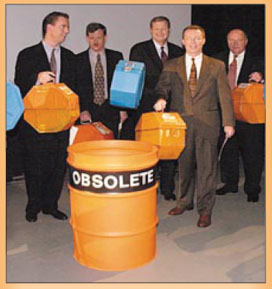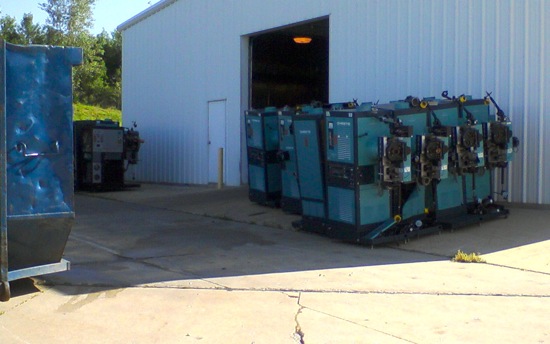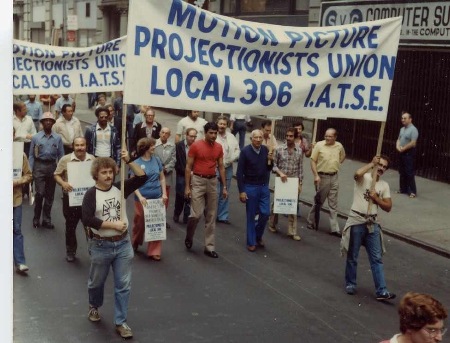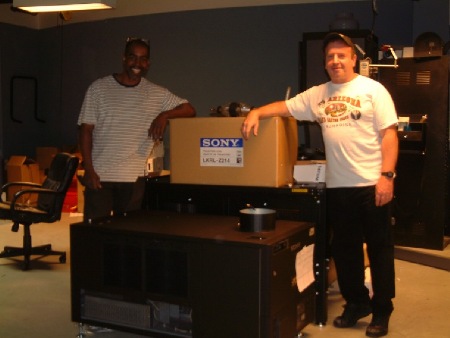The emulsion is on the wall, so to speak.
Film is finished as a mainstream exhibition format after more than a century. Roger Ebert, a long-time video projection skeptic, proclaimed as much a little over a week ago.
One can see where he’s coming from. High-end digital projectors have overtaken 35mm in the multiplexes. Kodak shares briefly flirted with penny stock status. The only good news coming from the company lately was, ironically, the leasing of laser projection patents to IMAX, which will shortly replace its last remaining 70mm installations with digital machines.
As film’s share of the market shrinks, there will be increasing pressure to discontinue the format altogether. The studios would rather it had been discontinued yesterday.
At first glance, digital represents a clear cost-saving. No more laboratories, no more prints, no more warehouses, no more trucks—a frictionless distribution infrastructure without the grease and rust. The future is shiny: hard drives, servers, eventually satellite transmission without any physical medium whatsoever. The next time some fussy filmmaker is haggling over final cut a week before release, there won’t be any rush orders at Technicolor—4,000 prints by Wednesday. The newly conformed digital intermediate can be uploaded by supper.

Of course, for the time being, trucks will still need to transport these hard drives, and, come to think of it, they will still need to sit on shelves in some physical building. (Call it an Asset Fulfillment Center if ‘warehouse’ sounds too industrial.) The distributors will save millions—though server farms aren’t free, either, and the bandwidth required to transmit 200 GB files to every theater in America is by no means trivial.
In part, this transformation presents ideological, rather than actual, advantages—allocating capital towards supposedly forward-looking ventures (IT infrastructure) rather than musty, out-moded industrial models. We can spend $200 million on the latest blockbuster but, at the end of the day, it will be built up from reels and spliced together with Neumade tape, projected on analog equipment that may be decades old. Efficient and reliable as this status quo has proved to be, it sounds vaguely second-rate, lacking in the largesse and casual flaunting of wealth that blockbusters demand. A new 4K digital projector fits the bill better.
Better yet, the new digital models boast a level of encryption that film could never match. The distributor can dictate when and how often a film is shown; access to the file is forbidden without the proper, studio-supplied ‘key’ (and, sometimes, it is forbidden or muffed even with the key, but that unforeseen problem is the subject of another column).
The advantages for exhibitors are less clear. It is true that the digital projector practically eliminates the need for the projectionist. But the projectionist’s union is a shell of its former self and many chains are already employing projectionists at compensation barely above minimum wage—and with the expectation that said employee oversees a dozen or more shows simultaneously. (It’s common to train a promising concession stand kid for projection duties—with the expectation that she returns to the floor and rips tickets or sweeps the floor between shows.) In other words, the labor savings are real, but marginal—and, in any case, in no way comparable to the capital outlay required for a new Sony or Barco.
High investment with minimal concrete return has kept many exhibitors from converting to digital. In many respects, the history of digital cinema can be told almost wholly in terms of the cost-sharing and financing measures pushed by trade groups over the last decade—proposed, reneged, rejiggered, abandoned, and eventually successful.

The ultimate solution—the Virtual Print Fee—finances the conversion through a credit that exhibitors receive for every title that they show digitally. The contracts between exhibitors, distributors, and manufacturers often stipulate, as Ebert points out, that the film projection equipment be discarded, dismantled, or destroyed—though it’s often in fairly good condition and may even be a recent installation.
Who pays for Digital Cinema 2.0, when the first generation of DCI-compliant projection equipment reaches the end of its natural life in the next few years, is an open, and important, question. Whereas Simplex and Century 35mm projectors survived and thrived for decades, with minimal and easily performed maintenance, today’s digital projectors are expected to last five to ten years. Will exhibitors shell out for new projection equipment that frequently?
One might cynically suggest that the conversion is designed to be non-reversible for this reason. In five years, some exhibitors, with aging digital equipment and some reliable analog parts in the closet, might be tempted to return to film, maybe even demand it. It is difficult to imagine a more unsettling, disruptive prospect.
The future of film is, necessarily then, not in the multiplex, or even the art house. The latter, in fact, is the most endangered species today; if unaffiliated with chains, they face substantial barriers to financing the digital conversion of their screens. Likewise, small distributors fronting independent and foreign films stand to see real savings through digital bookings—if only their client venues could afford the machines to play them.
And yet the mountain of film produced in the twentieth and early twenty-first centuries will neither disappear nor become intractably obsolete. The mass consumption viability of 35mm distribution and exhibition may well have an expiration date, but the individual prints do not, so long as existing equipment is well-maintained and the skills to project them are valued. Films are cultural treasures, after all, not old cartons of milk at the back of the refrigerator. Some short-sighted studios and production companies might discard their film holdings in whole or in part—but then, this has been the case throughout the entire history of cinema.

What remains? Thousands upon thousands of 35mm distribution prints, some heavily used and others barely played. The holdings of the non-profits archives, thousands more prints. Expand our sights and we find thousands more 35mm and especially 16mm prints scattered across universities, libraries, schools, churches, and community organizations throughout the country.
If we recognize that studio and archive holdings are, at best, incompletely cataloged and the rest hardly cataloged at all, then we are faced with the frightening and exhilarating fact that we scarcely understand film history—not just the totality of it, but simply the artifacts still within reach.
Whether this imposing body of film circulates in a post-film world is another question.
To be sure, we cannot assume that quality labs will be around forever. Many, including New York’s legendary DuArt and San Francisco’s Monaco, have either closed or become wholly digital operations in the last year. Short of an industry-wide initiative to keep film manufacturers and photochemical laboratories solvent, we may well face a future where film prints cannot be easily or cheaply replaced—or, indeed, replaced at all. DIY film processing units are an inspired thought, but even artisanal partisans must admit that a staggering amount of laboratory craft will disappear as workers with decades of experience retire or find themselves downsized. Operating an optical printer may well become a monastic skill.
Can any projectionist be trusted with an irreplaceable art object formerly known as a projection print? Can you trust the transport of such an object to FedEx or UPS? Would any theater owner willingly take on this liability when a digital copy is available? (That is, of course, assuming that a digital copy is available—an assumption worth serious scrutiny.)
Suffice it to say, those who cling to film will do so completely, evangelically—not, like many theater owners today, through historical inertia.
What shape will this new celluloid landscape take?

Ask an archivist or programmer or critic, and you’re likely to get one of two answers.
In one scenario, film becomes an elite activity. Patrons dress up and stand in line and pay premium ticket prices and speak in hushed tones of this original 35mm IB Technicolor print of McCabe & Mrs. Miller projected with xenon, or maybe even carbon arc. Like going to the opera—another once-popular art form now subsidized by a global elite. Venues can only borrow 35mm prints after a sizable investment.
Leaving aside entirely the political question of whether we want the cinema to become an elite experience, we must consider the practicality of implementing such a vision. Will people be able to see the difference between film and digital (Ebert says he often cannot anymore and he is not alone) and will they be willing to pay for it? More importantly, will elite institutions with conservative trustees and entrenched bureaucracies ever be the natural allies of the celluloid evangelists? Will they really be the best homes for the earnest, ideologically pure, materially-specific appreciation of cinema?
The future of film is probably a minority experience, but not necessarily an elite one. The other scenario revolves around individual action and essentially underground exhibition. Private film collectors will be around forever. They will build and maintain basement screening rooms, as they have for decades. Collectors will loan to each other and trade prints, like they do today. (All those prints being thrown into the dumpsters will have to go somewhere, right?)
Remember the point about multiplex chains discarding projectors as quickly as they can? In the next two years, there will be ample (and quality) projection equipment on the grey market priced scarcely higher than the cost of transportation. Anyone who wants a 35mm projector in her living room (bless her!) will be able to afford a true home theater. Inconceivable at any time in the past century, 35mm may well become a democratic medium.
In ten years, going to see a film may well mean going over to a friend’s house and seeing a 35mm print while reclining on the sofa. You will know everyone else in the room, or be introduced in short order. It will be a genuinely and deeply social experience, fully integrated and conscientious; you will be surrounded by people who care about the same things you do, coming together to witness another unreeling of this prized object.
Likewise, public venues that show film will trumpet this in every facet of their brand and obtain their prints through this underground network.
These parallel futures are not incompatible, but they are not likely to coincide. Neither will claim longevity or stability unless the people who truly care about film work towards such a future. With so many knowledgeable technicians and craftspeople still with us—in the lab, in the projection booth, in the archive, in the post-production house, in the film depot, even at the multiplex concession stand—we must begin the project of saving cinema and, perhaps, understanding it for the first time.
Watch this space for future articles about preserving cinema in a post-film world.
